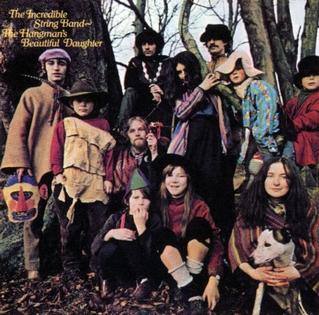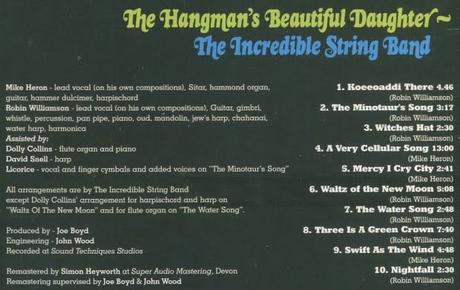
#músicaparaelencierro. Tremendo aporte de Marcelo para revivir otro de los clásicos de la increíble banda de cuerdas. Y nos dice: "Estoy disponibilizando dos albumes esenciales de la banda escocesa The Incredible String Band, principalmente activa en los anos 60-70. Su estilo es una conjugación de folk inglés con elementos de musica oriental y psicodelia. Es musica realmente exquista, espero que la disfruten". Así revivimos un disco que alguna vez había presentado el Mago Alberto, en una tarde a puro The Incredible String Band!
Artista: The Incredible String BandÁlbum: The Hangman's Beautiful Daughter
Año: 1968
Género: Folk rock / Rock jipón y sucio
Duración: 50:14
Nacionalidad: Escocia
Un discazo de esta banda jipona y piojosa por excelencia. Alberto (no podía ser de otra manera ¿quién traería esto aquí si no es él?) nos lo comparte e invita a conocer.
The Incredible String Band (abreviada en ISB) fue un grupo de folk psicodélico formado en Escocia en 1965 por Robin Williamson, Mike Heron y Clive Palmer y descubierto por el productor Joe Boyd. La banda contó con bastantes seguidores, especialmente dentro de la Contracultura inglesa, antes de disolverse en 1974. Se les considera pioneros del Acid folk y de la world music, por haber integrado en sus canciones formas e instrumentos muy variados de música tradicional. El grupo se reunió de nuevo en 1999 y se mantuvo en activo hasta 2006.Wikipedia
Entre los admiradores del grupo se cuentan músicos como Bob Dylan, John Lennon y Robert Plant. En España, músicos como Vainica Doble, Pau Riba y Fernando Márquez han manifestado su admiración por el grupo, así como Silvio Rodríguez en Cuba.

Y la verdad, no pienso decir nada del disco porque no lo escuché, pero aquí va el comentario del Mago Alberto:
Los primeros hippies de la epoca moderna sin lugar a dudas tenían a esta banda como nave insignia de sus principios filosóficos,y así sucedió por décadas, hoy es una banda referencial de aquellos años de comunidad, del esplendor del "flower power", de las eternas noches de sexo, droga y rock and roll, de patchuli, incienso, bongo, flautita dulce y piojos.Mago Alberto
Williamson y Heron fueron algo asi como el Gordo y El Flaco, el Alfa y el Omega de la Incredible String Band, en la decada del 70 escuchar a la Incredible era navegar en El Mar de los Sargazos, una experiencia religiosa, por cuanto fueron además de músicos y poetas innovadores, psicodélicos y honestos.
En cada uno de sus trabajos fueron muy importantes, las letras, algunas de corte netamente delirantes, otras místicas y hasta surrealistas como en el caso de La Canción del Minotauro, cantada desde el punto de vista de la mítica criatura.
La canción más interesante de esta obra denominada "The Hangman's Beautiful Daughter" es sin lugar a dudas "A very cellular song" curiosamente la más larga del disco, dividida en pequeños fragmentos con interesantes arreglos de clavicordio, flautas, violines y kazoo, si! mucho kazoo!!. La cancion habla de mañanas soleadas de buena energía, de sol, de buenas noches, de semillas, de celulas, de amor, y un mantra que se repite hasta casi entrar en trance (imaginate una noche de bosque, fogata, de porro, de guitarras, de mucha gente coreando estas frases y ya esta!!) esto es Incredible String Band.
Este trabajo es quizas el mas hermoso de la Incredible, el mas disfrutable, es básicamente un disco para escuchar sin reparos, por supuesto Williamson y Heron fueron una gran influencia para todo lo que vino después de los años 60, muchísimos músicos mamaron sin reparo de la teta de estos jóvenes escoceses, en particular las inflecciones de la voz en el canto, y los arreglos instrumentales, donde no falta nada, cuerdas, percusión, citaras, violines, flautas, guitarras, teclados, etc.
Ah... y por supuesto también estuvieron en Woodstock, en realidad estaban programados para abrir el mitico festival pero como llovía decidieron tocar al día siguiente, calculo que la imagen de ellos bañandose en vivo ante semejante multitud fue demasiado fuerte para la época, no quisieron romper con la religiosidad seguramente.
Una banda legionaria y fundacional esta presente hoy aqui con su folk psicodélico, para el beneplacito de los sucios y olorosos jipis, que nunca faltan en este blog.
Mierda, leo el comentario de Alberto y me da asco, sucios jipis llenos de piojos y roña... o sea, todo bien con el flower power, la vida cachegue, la revolución social, las drogas, el delirio místico, el amor libre, pero... ¿hacía falta la mugre y los piojos?. Les dejo esta disco, que es la quintaesencia del espíritu jipi, pero les aseguro que si entro al blog y siento olor a sucio lo borro de nuestro catálogo. Así que por favor, báñense, al menos una vez por semana.
Vamos con otro comentario que no es de Alberto:
Aunque la frase es manida, siempre vale recordarla. Según Proust, los verdaderos artistas son aquéllos capaces de abrir las puertas hacia un mundo desconocido, en el cual jamás se ha puesto un pie. La inveterada propuesta de Incredible String Band refrenda la sentencia.Rodrigo Burgos Cartes
¿Quién dijo que para reivindicar un ánimo psicodélico eran necesarios un bajo con fuzz, overdubs, distorsión y arsenales electrónicos?
Desde 1966, el dúo conformado por Robim Williamson y Mike Heron se prodigaron en explorar en las tradiciones vernáculas y añosas de la campiña bretona, oculta en las inmemoriales leyendas de toda una pléyade de seres fantásticos e imposibles personajes; el tándem reinterpretó desde un prisma vanguardista y lisérgico toda la oralidad vertida en las músicas pastoriles originarias inglesas.
Antes de la publicación del monumento folk que amerita estas líneas, ya habían sacudido las bateas con 5.000 Spirits or the Layers of the Onions en el '67. Para el año siguiente, la propuesta serpenteante, quebradiza y absolutamente personal de los ISB estaba ya madura en su esperpéntica belleza.
Dos instrumentistas eximios, ingiriendo más de la cuenta cubos de LSD y con unas posibilidades musicales inmensas, dieron frutos en esta honesta y magistral odas a la mitología celta en su lectura más alucinógena.
Estructuras complejas, instrumentos recónditos y desconocidos, dulces voces bucólicas infectadas de la revolución de entonces: experimentando con lo arcaico, podría ser un epígrafe de este álbum que, mayor sorpresa, alcanzó el puesto cinco en ventas en el Reino Unido, una fortuna que ya se hubiesen querido los Velvet Underground, Silver Apples y tanto obseso que anduvo suelto por entonces.
"Waltz of New Moon", "The Witches Hat", "A Very Cellular Song", "There is a Green Crown", "The Minotaur's Song", son parte de un viaje condimentado con sítares, dulcímeres, flautas de agua, y una serie interminable de vetustos y nobles instrumentos acústicos usados por incontables generaciones de labriegos, pastores y juglares de la vieja Bretaña.
Un generoso deleite y una apertura hacia el frondoso follaje de los secretos celtas.
Y ahora vamos con los consabidos comentarios en inglés:
The Hangman’s Beautiful Daughter stands as the Incredible String Band's undisputed classic among critics and musicians alike -- ask Robert Plant, who touted its influence on Led Zeppelin's first album and general direction. Recorded and released in 1968, the album hit number five on the U.K. album charts, and was nominated for a Grammy in the U.S. It was produced by Joe Boyd, and engineered by John Wood using 24-track technology. Robin Williamson, Mike Heron, and Licorice McKechnie also utilized the talents of Dolly Collins (vocals, flute, organ, and piano), and David Snell (harp). Williamson and Heron employed a vast array of instruments on these songs including sitar, gimbri, pan pipe, oud, chahanai, mandolin, guitars, Hammond B-3, dulcimer, harpsichord, pan pipes, oud, water harp, and harmonica. The songs were much more freeform and experimental. Check Heron’s 13-minute “A Very Cellular Song,” which incorporates elements from a Sikh hymn and a Bahamian spiritual. Using the Hammond, a gimbri, pan pipes, handclaps, and other instruments, it begins on a two-chord vamp that employs a vocal round in five-part harmony, with secular and spiritual lyrics. It’s simply infectious. Other notables include the stellar “The Minotaur’s Song,” with its call and response chorus played on guitars, upright piano, and six-part harmonies. It melds a children's song with a drinking song to humorous and utterly memorable effect. Elsewhere, “Waltz of the New Moon,” employs two-chord drones on acoustic guitar with a meld of Middle Eastern vocal styles and Scottish field songs. “Three Is a Green Crown” is a psychedelic folk song in all its hypnotic droning glory with Williamson’s primitive sitar playing featured prominently. The tender, exotic, "Nightfall,” the album’s closer, is a lullaby, with guitar and sitar accompanying the vocal in whole tone intervals. The Hangman’s Beautiful Daughter is the most ambitious, focused, and brilliantly executed record in ISB’s catalog.Thom Jurek
The Pure Light Within ItAnthony Carew
You'd think having the blessing of the church would be anathema to counter-cultural credibility, but when the Archbishop of Canterbury, Rowan Williams, calls the Incredible String Band's music "holy," he's onto something. Take "A Very Cellular Song," the 13-minute centerpiece of the Scottish folk oddballs' undoubted masterpiece, 1968's awe-inspiring The Hangman's Beautiful Daughter. Across its long, shifting structure, Mike Heron draws connections between all life forms, from the divine down to the amoebic; the wonders of the universe alive in every spirit, every cricket, every dividing cell.
The lyrics are matched to musical pantheism, the song drawing broadly from religions —incorporating an English traditional, a Bahamian spiritual, and a Sikh hymnal— and sounds —featuring oud, gimbri, shenai, sitar, and panpipes— as it meanders into a series of strange, kooky, daydreamy shapes.
The Hangman's Beautiful Daughter, in its entirety, works with the same sense of complete inclusion; Heron and Williamson not letting their status as folk-revivalists keep them from taking music into weird new hybrids never before heard. This was, after all, 1968. With weed on the minds and dreams in the sky, the pair were drawn to folk music not for its traditionalism, but its radicalism. This people's music, as flowing with pagan rites as Christian tenants.
It's spiritual music, but it's the free-flowing, open-minded spiritualism of the hippy ideal: all cultures, all worlds, all creeds, all genres united under one weird strain of high, high, holy art.
1968
Where many classic albums have achieved that status because of their timelessness, this isn't the case with The Hangman's Beautiful Daughter. This is an album forever tethered to a specific moment in time; a record whose absolute artistic goodness gives rise to the mythicism so many imbue 1968 with.
The album operates with a sense of pure libertarian, artistic freedom that, in the years prior, seemed not to exist. Williamson and Heron, themselves, started out with more timidity; their early days finding their folk less freaky, more coffeehouse; their debt to Dylan obvious. It took them a while —this was their third album— to feel such a sense of abandon.
Drawing from Indian, Afghan, and Moroccan folk, featured crazy cascading vocals, an army of bizarre interests, a sense of cosmic internal logic, and a happy balance between the transcendent and the absurd, The Hangman's Beautiful Daughter is the happiest by-product of a cultural revolution.
For listeners, now, part of the appeal in listening to it is that it lives up to the imagined hippy ideal; gives rise to the myths of a golden age of counter-culture that, in many ways, never really existed. It's not a perfect portrait of the idyllic countryside like Vashti Bunyan's recently-beloved Just Another Diamond Day, an album on which Williamson, not coincidentally, played. But it is a wondrous, ridiculous, mind-altering record that's remarkably free from self-consciousness, self-censorship, cynicism, and the corrosive presence of cool.
Holy holy all is holy. The band would not shun me if I were to sell my records to fund some nasty habit; they would shun the habit. Not even! They would cast the habit into higher arms and take me with loving dance into forests. They look, I suppose, for the snake in the dirt and blow kisses at its shedding and enjoy the openings between mammoth trees. They'd toss bodies wide in the woods their castle and make love near the sound of living water. They would take me and tell me not to fear this and that, but to know not to interfere with such and such. They know about places and order and salivate and widen eyes when they see wings. Growth and circles fascinate them as they burrow themselves in psalms and proverbs, and yell like boys into the diaspora- the fleshed busyness of the city germ. They would celebrate a locust take flight and flow tears at season's change- but before long they would celebrate the turning too and so would, in fullness, cry and laugh. Loving bards let feed upon the motion of planets. Loving men wear the burdens and organic jewels of the free and sensual, they who roam. It's alive here, on record.Horton Scorton
If you find that you are unable to enjoy this album it is very likely that what you are suffering from is a common psychological malady caused by spongiform encephalopathy which leads naturally to an acute sensory malfunction and the best thing for you to do is to get yourself a healthy dose of the appropriate medication and lighten up already.hotcakes
Stubbornly this album is on every list I make. I don't care, it's a kind of magic. Some denied its qualities by accusing the band to be a sordid bunch of hippies - and that's not true. The best music is always above all chronological tablet. Who is supposed to reject the charming of some children's tales or a warm story beyond the fire? Now please don't tag them as pretentious or musically dated. This spellbinding album is the real proof of one of the most creative periods of the musical history (1965-1975), constantly underrated by some sort of overwhelmed intelligentsia. Also established a genre: psychedelic folk, now called wyrd folk, freak folk or simply psych folk.Anton Bildern
I took my username from this album. So I must love it, right? Well of course I do. But do I really? Why do I love the sound of two Scottish men howling at me like the do in Swift as the Wind? Why do I love the sound of someone with only a rudimentary grasp of the sitar hammering away the instrument like Mike does in Three Is a Green Crown? Why do I love the sound of Robin trying to sing as many notes per syllable as possible like he does in Waltz of the New Moon? Why do I love the sound of Mike, Robin and an uncredited Fairport Convention bellowing an imitation of a minotaur? Why do I want to hear an ode to an ameoba midway through a totally unrelated song? Why? Because I like the sound of rampant imagination running wild without the slightest hint of inhibition or self-consciousness getting in the way of things, that's why.koeeoaddi_there
I can't believe I only give this 4.5 stars originally, it's worth at least twice that. Basically, I've had this CD for a number of months now, and I've heard it probably about 2000 times, and haven't got bored of even one second of it.DarknessFish
In case you weren't aware of it, it's a trippy, psychedelic folk album, original and beautiful, with some of the catchiest tunes you'll ever hear. "A Very Cellular Song" is perhaps the greatest song ever recorded that lasts over 10 minutes, it's appropriation of The Pindar Family's "Bid You Goodnight" is simply stunning, and melts my heart every time I hear it.
If you were thinking of buying only one folk album in your life, well, you're a bit of a muppet, but if so, get this one
Y ya saben, se me bañan!Lista de Temas:
1. Koeeoaddi There
2. The Minotaur's Song
3. Witches Hat
4. A Very Cellular Song
5. Mercy I Cry City
6. Waltz of the New Moon
7. The Water Song
8. Three Is a Green Crown
9. Swift As the Wind
10. Nightfall
Alineación:
- Robin Williamson / vocals, guitar, gimbri, penny whistle, percussion, pan pipe, piano, oud, mandolin, jaw harp, chahanai, water harp, harmonica
- Mike Heron / vocals, sitar, Hammond organ, guitar, hammered dulcimer, harpsichord
- Dolly Collins / flute organ, piano
- David Snell / harp
- Licorice McKechnie / vocals, finger cymbals
- Richard Thompson / vocals on "The Minotaur's Song"
- Judy Dyble / vocals on "The Minotaur's Song"

